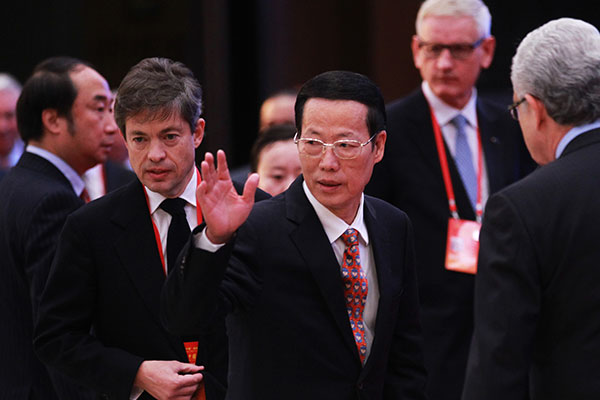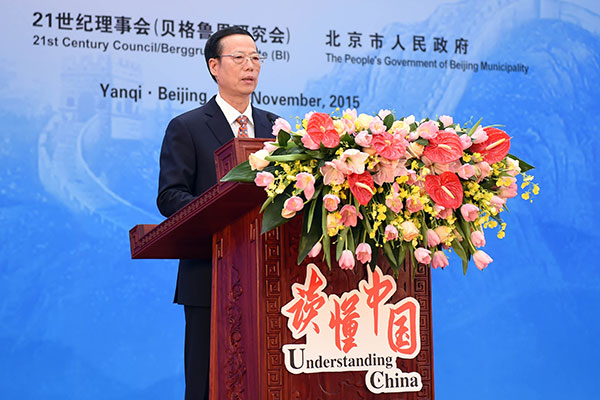
Vice-Premier Zhang Gaoli attends the opening ceremony of the 2nd Understanding China Conference in Beijing on Nov 1. [Zou Hong / China Daily]
China is aiming to maintain an average annual GDP growth rate of 6.5 to 7 percent until 2020, without aggressive stimulus or blind expansion of investment, said Vice-Premier Zhang Gaoli on Nov 1.
“If China can successfully achieve the 13th Five-Year Plan (2016-2020), we will avoid the middle-income trap, which will be a miracle in the world’s development history,” said Zhang, in his speech during the opening ceremony of the 2nd Understanding China Conference.
The conference, in Beijing, was jointly hosted by the government think tank China Institute for Innovation and Development Strategy, Chinese People’s Institute of Foreign Affairs and the US-based 21st Century Council.
“We predicted that from 2011 to 2015, the average annual growth rate would achieve 7.8 percent,” said Zhang.

Vice-Premier Zhang Gaoli addresses the 2nd Understanding China Conference in Beijing, Nov 1, 2015. [Photo/Xinhua]
He said that innovation was the key to driving development, and major problems should be solved during the economic restructuring reforms.
The fast but unsustainable development model should be abandoned, he said.
Economists predicted recently that it was unlikely to see a fast rebound in the fourth quarter, and a 6.9 percent GDP growth is possible.
This would mean no change from the third quarter’s 6.9 percent growth, the first dip below 7 percent since the global financial crisis.
The trend has also been suggested by the latest data.
The National Bureau of Statistics reported on Nov 1 that manufacturing contracted in October for the third straight month and the service sector saw slower growth.
The manufacturing purchasing managers index was 49.8 in October, below the 50 level that separates expansion from contraction, and the same as in September.
Meanwhile, the figure for nonmanufacturing sectors, including service and construction businesses, fell to 53.1, compared with 53.4 in September.
Zhao Qinghe, an economist at the NBS, said that further cooling of the manufacturing sector is possible due to the fragile global recovery.
“Export and import in this sector may remain weak,” he said. There remains a long-term slowing trend of the traditional manufacturing industry with overcapacity problems.
Hence, the government is promoting innovation and accelerating restructuring reforms to help unlock new sources of growth and shift the driving force toward service and consumption,
According to the bureau, in the first three quarters, the service industry contributed 51.4 percent of the nation’s economic output, up from 48.2 percent in 2014.
The manufacturing sector accounted for 40.6 percent of the GDP growth in the first three quarters, down from 47.1 percent last year.
The fifth plenary session of the 18th Central Committee of the Communist Party of China closed on Oct 29 with a brief statement that put economic growth back in focus.
The plenum reiterated the goal to double the GDP and per capita income by 2020 from the 2010 level, which requires an annual average growth rate of 6.5 percent over the next five years.
